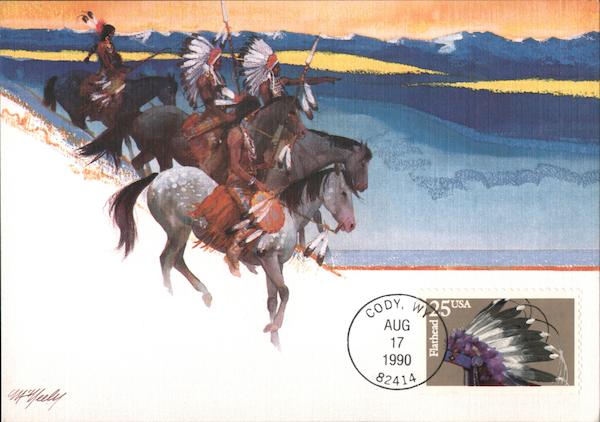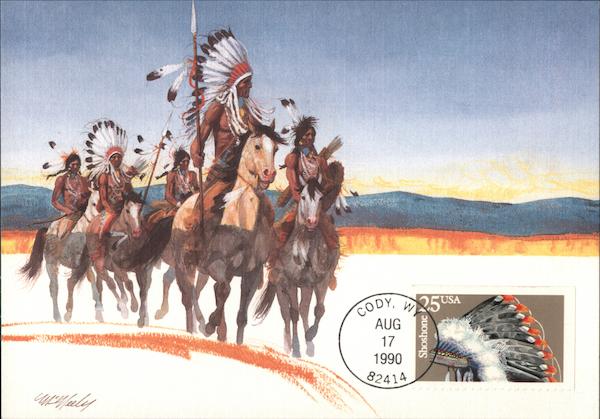Set of 5: 1990 Native American Tribe Series
Front:
CODY. W25USA
17
1990
82414
Assiniboine
CODY, 5USA
17
1990
82414
Cheyenne
25USA
CODY,
GOGOGGOO
17
1990
82414
Comanche
CODY, W25US
17
1990
82414
Flathead
CODY, 5US
25USA
17
1990
82414
Shoshone
Back:
ASSINIBOINE
First Day of Issue: August 17, 1990
First Issue Location: Cody, Wyoming
The showy, elaborate headdress, as in all Assiniboine
clothing, reflected the tribe's taste for the beautiful and
colorful. Materials obtained in trade were often used in
their clothing, with such items as their headdresses con-
taining wool, brass tacks, beads, felt and other cloth. The
headdresses also contained items of the land — eagle
feathers and ermine. Early travelers into the northern
plains of the Assiniboine were immensely impressed by
the tribe. George Catlin, an artist who traveled the area in
1832, noted of the Assiniboine that they “are undoubtedly
the finest-looking, best-equipped, and most beautifully
costumed of any on the Continent ..." Living in the
rolling, open prairie of Saskatchewan and Manitoba,
Canada, the Assiniboine were influenced early on by
British traders of the Hudson Bay Company. The Cree
Indians to the north were close allies of the Assiniboine
and acted as “go-betweens" with their southern neigh-
bors and the British of the Far North.
No. 90-28
©1990 The Maximum Card Collection
A Division of Unicover Corporation • Cheyenne, WY 82008-0007
Original painting by Tom McNeely
CHEYENNE
First Day of Issue: August 17, 1990
First Issue Location: Cody, Wyoming
For the Cheyenne, as for all Indians, the elaborate feath-
ered headdress was a symbol of immense power and
great medicine. Those who wore it were the recipients of
that power. One such Cheyenne warrior was the mighty
Bat — known as Roman Nose to the whites — who stood
six-foot, three-inches tall and was thought to be invin-
cible in battle. Roman Nose wore a magic headdress so
powerful that whenever Roman Nose wore it into battle,
he was untouchable; bullets and arrows whizzed past
him time and again. The huge man delighted in proving
his prowess, loping on his horse casually across the
enemy's line of fire without harm. However, the medicine
of this headdress was neutralized if Roman Nose hap-
pened to eat anything served with an iron instrument.
Accordingly, he diligently avoided the white man's uten-
sils. But on the eve of a battle with fifty frontiersmen in
1868, he accidentally ate a piece of bread taken from a
skillet with a fork. The next day, Roman Nose was
mortally wounded on the battlefield.
No. 90-29
©1990 The Maximum Card Collection
A Division of Unicover Corporation . Cheyenne, WY 82008-0007
Original painting by Tom McNeely
COMANCHE
First Day of Issue: August 17, 1990
First Issue Location: Cody, Wyoming
Today, the headdress of the Comanche resembles that of
the Sioux and other tribes of the northern plains. But long
before the Comanche were placed on reservations where
they adopted such garb, they had developed a very
distinctive headdress all their own. This was the infamous
horned headdress, made from the scalp of a buffalo bull
with the horns still attached. Fierce Comanche warriors
wearing such garb were a frightening sight to their ene-
mies as they charged to battle upon their legendary
horses. To the Comanche, the mighty buffalo bull was an
animal with great stamina and power — qualities which
were necessary in war. The headdress might also contain
a bit of hair from a favored horse because the Comanche,
over all tribes, loved a good horse. Before horses were
introduced into the New World by the Spanish, the
Comanche lived in the Rocky Mountains and were actu-
ally an off-shoot of the Shoshone tribe. But the tribe
moved down onto the flat, open southern plains in the late
1600s and became expert horsemen.
No. 90-30
©1990 The Maximum Card Collection
A Division of Unicover Corporation • Cheyenne, WY 82008-0007
® Original painting by Tom McNeely
FLATHEAD
First Day of Issue: August 17, 1990
First Issue Location: Cody, Wyoming
Though many Indian tribes clashed time and again with
the invading white men, early relations between whites
and the Flatheads were generally friendly. This friendship
was reflected in the headdresses of the tribe. Made from
the tail feathers of a Golden Eagle, the headdress often
contained products obtained in trade with the white man,
such as wool, felt, beads and other items. Typically used
only for very important events, the headdress was most
often worn into battle with the tribe's neighbors and
traditional enemies, the Blackfeet. The Flathead Indians
traded often with the white man, first in beaver pelts
during the mountain man era, then in buffalo robes as the
demand for beaver tapered off. The Flathead tribe also
adopted Christianity, with a Jesuit priest, Father Peter John
De Smet playing an important role in converting many.
Among the early pioneers, the Flathead were thought to
be intelligent, honest and peaceful.
No. 90-31
©1990 The Maximum Card Collection
A Division of Unicover Corporation • Cheyenne, WY 82008-0007
® Original painting by Tom McNeely
SHOSHONE
First Day of Issue: August 17, 1990
First Issue Location: Cody, Wyoming
Into the headdress of the Shoshone went pieces of the
north-central Rocky Mountains where they lived. From
the high, rocky crags came the tail feathers of a Golden
Eagle; the deep snows of the high country yielded the fur
of an ermine; from forests of pine and spruce came the
feathers of the flicker and the quills of a porcupine. And
each piece of the headdress had a special meaning: the
ermine fur and eagle feathers gave the wearer protection
... the flicker feathers had healing powers. Great effort
went into the making of each headdress — prepared by
the elders through an elaborate ceremony and accompa-
nying song — thus only the very great men of the
Shoshone wore this badge of prestige and honor. Among
the Shoshone, the chieftain did not obtain his prowess
through heredity, it was obtained only through acts of
bravery and valor. These deeds were then reflected in the
headband of the war bonnet – for every great feat two
holes were awarded.
No. 90-32
©1990 The Maximum Card Collection
A Division of Unicover Corporation . Cheyenne, WY 82008-0007
® Original painting by Tom McNeely












